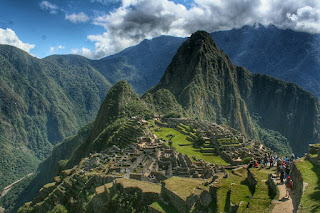Rising at 3am was not just to get to the final checkpoint before the gate before the 200 other hikers hoping for a glimpse of the Inca citadel. No, it was the only opportunity for the porters to pack up the tents and cooking gear before racing down to Aguas Calientes town for the 5:30 train - one of only two a day that allows their enormous packs on board.
So, at around 4am, we were sat in line in the darkness at the checkpoint, waiting for it to open at 5:30. It opens only then, so as to stop people walking in the pitch blackness to the site along narrow paths with perilous drops on one side. By the time we were through, the sky was lightening rapidly and we had only a few short kilometres to go before the gate.
The view from the gate down into the valley was misty, as we had been warned it might be. We stared in vain, trying to discern the shape of the ruined town through the thick blanket of white. As more people arrived, the cloud started to move and, finally, revealed the vast network of walls and rooms that make up Machu Picchu, standing at the foot of Huayna Picchu - the peak rising behind it.
 |
| The clouds part |
Walking down towards the town, I was soon reunited with K, looking the picture of health in comparison to her enfeebled self of two day's ago, on the verge of passing out with every step. Together we were guided round the site, which exhibited the same well-preserved pitch-roofed structures as Wiñayhuayna, but over a much larger area. We stood, watching as the first rays of light hit the stone ruins and, as soon as it did, the sunshine bounced off the water particles in the air, completely obscuring the view. We sat and waited until the fog cleared.
 |
| Iconic view of Machu Picchu |
The reason Machu Picchu town - situated in a secluded spot in the saddle between the two peaks whose Quechua names mean "Old Mountain" and "New Mountain" - has survived so long, is that it has solid foundations. Approximately 60% of the Inca's construction efforts went into digging down to the bedrock of the mountainside and building up firm walls to the surface, on which to base the aboveground structures.
 |
| Solid foundations required |
Machu Picchu was 'discovered' in 1911 by US anthropologist, Hiram Bingham in his search for the last city of the Incas. In fact, he was led there by a local farmer who had come across it previously.
Few are sure how many people were permanently resident in the city. The number houses gives a god indication, but the neighbouring terraces suggest that the crops could support fewer than were houses. Of course, as the capital, food may well have been delivered to it from neighbouring towns, and the water supply was plentiful - at least, given the sparing use that the Incas and modern-day Peruvians make of it. Overall, Machu Picchu could probably have supported thousands that may have flocked to it for certain events during the year. Certainly, it swallows several hundred tourists each day and still has room for a few wandering llamas.
 |
| Machu Picchu residents |
There is evidence that the archeological site was once a town of significance for rituals and astronomical observations. Given its position, both sunrise and sunset can be seen and the central Temple of the Sun has windows built aligned with the sun at winter and summer solstices. This structure demonstrates the same particularly fine stonemasonry as the curved walls at Cusco's Qorikancha.
 |
| Temple of the Sun |
Wandering the network of passageways and rooms was a fascinating, if uncomfortable, experience given the baking sun and with the mounting crowds of people. A few of us decided to escape to the "Inca bridge".
 |
| Bridge of doom |
A narrow and vertigo-inducing path winds west from the ruins around the mountainside until it abruptly stops. The Incas left a large gap in the wall on the cliff side, which is bridged by a few pieces of timber. This could be drawn up for protection in times of need, rendering the city inaccessible from this direction.
Having had our fill of the mysterious Inca ruins (not to mention the crowds, which were such a contrast to the preceding peaceful few days), we took a bus down the winding roads to Aguas Calientes.
This town, built up around the hot springs that give it its name, has flourished into one of the richest places in Peru solely because of the tourism that descends upon it each day of the year. As such, there is little to recommend it. It offers streets lined with restaurants and hotels aimed at visitors beginning or ending there journey and little else. We took lunch of a hearty and healthy bowl of quinoa soup in Apu Salkantay before bidding farewell to out guide and travelling companions and heading to the train station.
A remarkably clean and efficient train runs between Aguas Calientes and Ollantaytambo, where we stayed before the start of our hike. From there, a bus returned us to Cusco and the soft bed and warm bath of El Puma hotel. Such comforts were gratefully received after the long trek and days of 'agua caliente' delivered in a bowl for washing - even if acquiring a plug for the bath required a farcical amount of pleading with the reception staff that was worthy of Fawlty Towers. We ventured out only briefly for the ludicrously good value set evening menu at El Olivo - 4.5 soles for a soup, 'arroz cubano' or 'saltado', and a mate - after which I slept very well indeed.
No comments:
Post a Comment